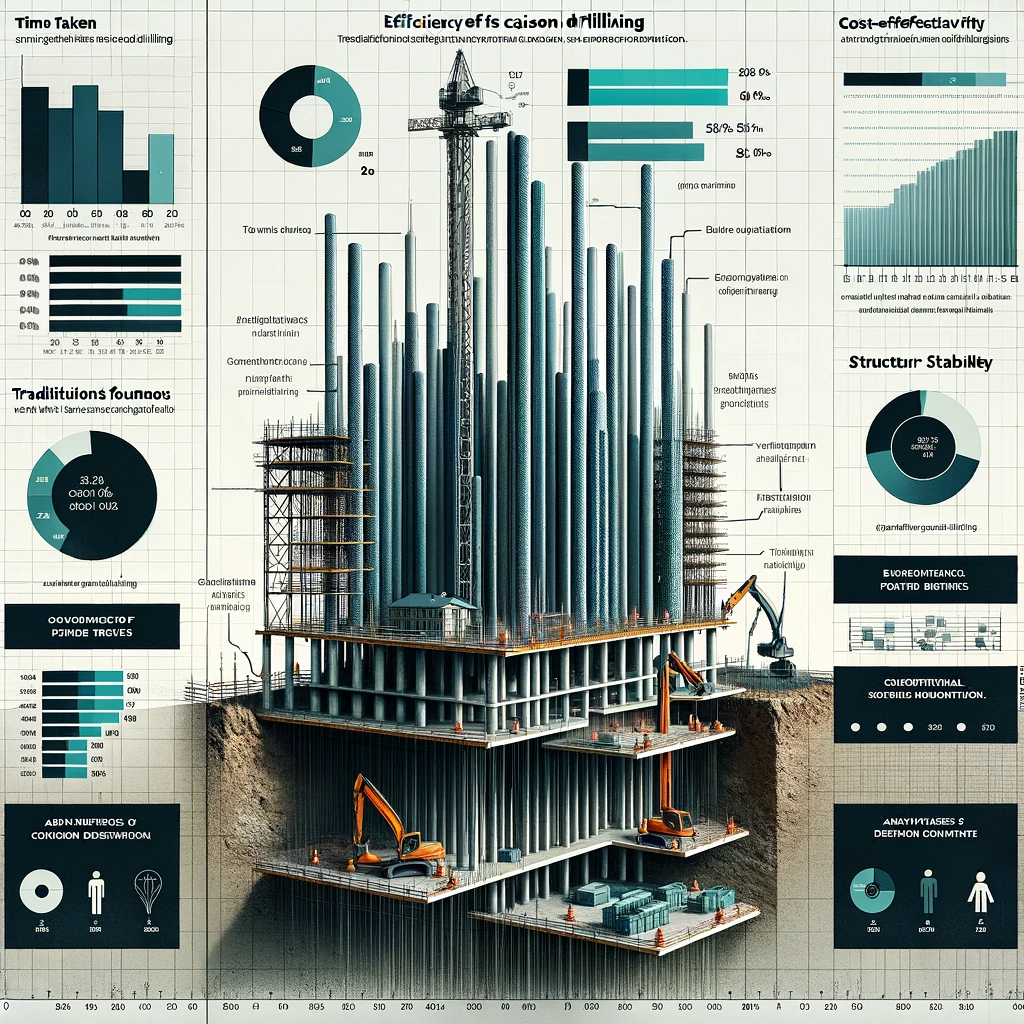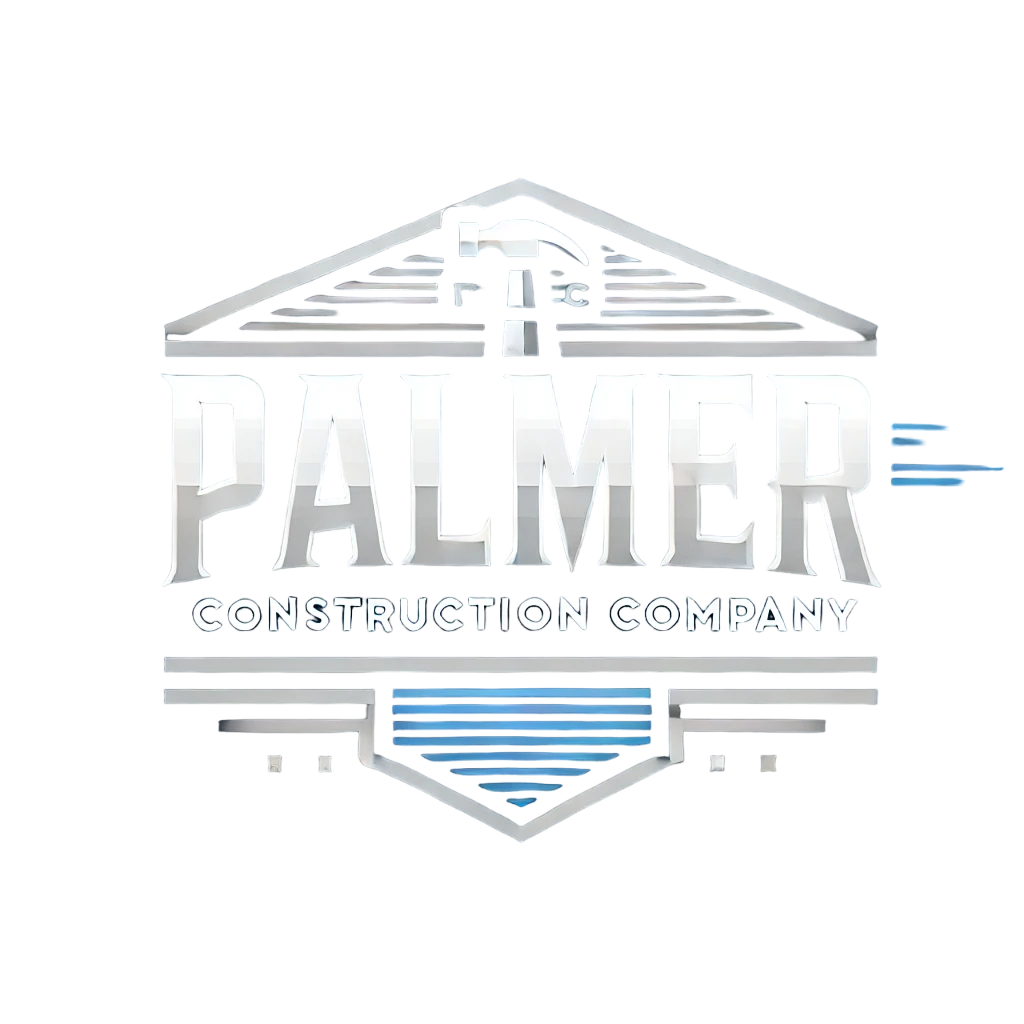Understanding Caisson Drilling in the Construction Industry
Exploring the Efficiency of Caisson Drilling in Modern Construction, the foundation technique known as caisson drilling plays a vital role in ensuring building stability and integrity. Caisson drilling involves creating a hole in the ground, often below waters, to provide a stable base for structures such as skyscrapers and bridges. This technology and its application have revolutionized the construction process, offering numerous benefits. By using concrete-filled caissons, construction professionals are able to overcome challenging ground conditions and ensure safety in waterlogged grounds. Through soil analysis techniques and careful considerations, the process of caisson drilling is tailored to suit specific environments, ensuring the stability and integrity of the foundations. To further explore the efficiency of caisson drilling in modern construction, case studies provide valuable insights into the method and its success in various building projects.

Basic Principles of Caisson Drilling
Exploring the Efficiency of Caisson Drilling in Modern Construction involves the analysis of drilling techniques and equipment used in this activity. Caisson drilling is an excavation process that has seen advancements in technology, resulting in the use of more efficient systems. One of the key aspects of caisson installation is the assessment of factors such as water intrusion, air pressure, and depth accuracy. To ensure the strength and accuracy of caisson placement, drilling rigs equipped with specialized equipment and techniques are utilized. However, weaknesses such as the potential impact on surrounding areas and the disturbance of existing voids pose challenges. Therefore, site analysis and construction technology must be carefully considered to ensure that caisson drilling is a viable and efficient option for construction projects.
Modern caisson drilling has witnessed a leap in efficiency, thanks to advancements in construction technology. The Marina Bay Sands in Singapore is an excellent example of the potential of caisson systems in sustainable and efficient construction projects. The integration of AI technology and eco-friendly practices has further enhanced the versatility and strength of caissons, making them suitable for anyone exploring modern drilled caissons. However, safety remains a critical aspect in caisson drilling, and a combination of proper training, adherence to safety protocols, and the use of advanced equipment is essential. By exploring the efficiency of caisson drilling in modern construction, the industry can continue to embrace new trends and eco-friendly practices, ensuring sustainable and safe construction projects.
Significant Types of Caisson Drilling Techniques
Exploring the Efficiency of Caisson Drilling in Modern Construction has led to the development of various methods and techniques to enhance the effectiveness of this innovative drilling process. With advancements in technology, caisson drilling has become the forefront of revolution in the construction industry, especially for landmark projects such as skyscrapers and bridges. Different types of caisson drilling techniques have been introduced to meet the specific requirements of construction projects. These techniques include drilled caissons, which involve the use of monitoring systems such as GPS and engineering advancements to ensure safety and efficiency in the drilling process. Architects and engineers have explored the possibilities of using modern drilled caissons to create efficient and stable structures, pushing the boundaries of the field of caisson drilling technology.
Additionally, the impact of caisson drilling techniques on efficiency in modern construction cannot be overstated. The process of drilling caissons requires skilled workers who have undergone proper training and are well-versed in the safety protocols and adherence to the necessary precautions. Safety features and monitoring techniques have been integrated into the drilling systems to ensure compatibility and minimize hazards during the construction process. These advancements in technology and safety have paved the way for more complex and innovative caisson drilling methods to be utilized in the construction industry. As a result, modern caisson drilling has revolutionized the way buildings and other structures are constructed, offering improved efficiency and reliability in the construction realm.
Applicability and Suitability of Caisson Drilling in Construction
Exploring the efficiency of caisson drilling in modern construction is crucial to understanding its applicability and suitability in the industry. Construction workers rely on the precision and accuracy provided by caisson drilling, enabled by computer-aided designs and advanced technologies. The ability to adapt to different drilling conditions through ongoing research and innovative designs ensures sustainability and minimal impact on ecosystems. Automation reduces the risk of accidents and creates a safer environment for labor-intensive drilling processes. Modern drilling rigs and methods address the challenges faced in traditional practices, providing efficient solutions. The use of machine learning and other innovations optimizes drilling processes, leading to cost savings and enhanced capabilities. For instance, materials and construction projects around the world bear testament to the role caissons play in creating resilient structures and shaping the skylines of modern cities. The efficiency of drilled caissons in foundation work is particularly evident in challenging soil conditions, where stability is critical. In conclusion, the exploration of efficiency in caisson drilling highlights the importance of this process in modern construction and the frontiers it continues to push in the industry.
Construction Scenarios Favoring Caisson Drilling
Exploring the Efficiency of Caisson Drilling in Modern Construction, caissons have proven to be a stable and beneficial option for supporting structures in various construction scenarios. Whether it is for building foundations, bridge structures, or other construction projects, caissons provide durability and flexibility. With different types of caisson construction techniques and tools available, they can be used in various areas and placements around the world. The use of caissons ensures a strong foundation structure, especially in areas where the ground may be unstable or the water table is high. In modern construction, the efficiency of caisson drilling plays a significant role in ensuring the stability and longevity of structures.
Exploring the Efficiency of Caisson Drilling in Modern Construction, modern caisson drilling techniques have revolutionized the construction industry. Drilled caissons, specifically, have proven to be an efficient option for building foundations and other support structures. With the expertise in caisson drilling and the use of modern drilling equipment, caissons are efficiently placed deep into the ground, reaching the bedrock for added stability. The process involves drilling holes, placing casing and concrete tubes, and diving into the nitty-gritty of the construction world. The efficiency of drilled caissons ensures that the structures have a solid base, providing the required support and flexibility. The benefits of exploring the efficiency of caisson drilling in modern construction cannot be overstated, as it ensures the durability and stability of buildings and other structures.
Advantages of Caisson Drilling in Construction Processes
Exploring the Efficiency of Caisson Drilling in Modern Construction, one of the significant advantages of caisson drilling in construction processes is its ability to provide a stable foundation for buildings and structures. By using caissons, engineers can test the soil conditions and choose the most suitable construction technique. Caissons can be drilled to various depths and sizes, making them adaptable to different soil types and building demands. Additionally, caissons provide reinforcement and durability to the building foundations, ensuring long-term stability. This makes caisson drilling an excellent choice for modern construction, where the efficiency and strength of structures are crucial.
Another advantage of caisson drilling in construction processes is its ability to minimize environmental damage and reduce the carbon footprint. Unlike traditional construction techniques that require extensive excavation and soil displacement, caissons are drilled vertically into the ground, minimizing the amount of soil disturbed during construction. This not only reduces the amount of site cleanup required but also preserves the interior ecosystems. Furthermore, caisson construction requires less equipment and materials compared to other building techniques, resulting in reduced energy consumption and waste. These factors contribute to the overall sustainability and environmental friendliness of caisson drilling in modern construction.
The Process of Caisson Drilling in Modern Construction
Exploring the efficiency of caisson drilling in modern construction is of utmost importance as it plays a significant role in the construction of various structures such as skyscrapers, bridges, and towers. Caisson drilling is an efficient drilling technique that allows for the construction of deep foundations in a range of soil conditions. The process involves drilling a caisson hole, which is then filled with material to provide support and stability for the structure. In addition to its efficiency, caissons offer numerous advantages, including the ability to withstand extreme weather conditions such as frost heave and floods, as well as earthquakes. They also provide design options and can support heavy loads. The use of caissons in construction projects is expected to witness significant growth, as indicated by industry statistics and reports from marketsandmarkets. Furthermore, caissons are known for their eco-friendliness, as they are often made with corrosion-resistant materials and can be designed to meet specific specifications. Exploring the efficiency of caisson drilling in modern construction is crucial for enhancing the integrity and longevity of modern buildings.
StepbyStep Execution of Caisson Drilling
Exploring the Efficiency of Caisson Drilling in Modern Construction, the step-by-step execution of caisson drilling plays a crucial role in ensuring the successful construction of structures. To begin, the construction site is prepared by clearing the ground level and ensuring proper access for equipment and resources. Next, a diesel engine-powered drill is used to create a hole in the ground. The drill, equipped with a core made of wood or fiberglass, steadily penetrates the ground to the desired depth. Once the hole is completed, a steel footing is inserted into the drilled caisson, providing reinforcement and stability. This process is repeated for each caisson required for the construction project, ensuring the load-bearing capacity of the structure.
In order to achieve efficiency in modern caisson drilling, several factors need to be considered. The diameter and depth of the caissons are determined based on the specific requirements of the project. The use of pre-fabricated caissons allows for faster installation, reducing the construction time. Additionally, the use of plastic, PVC, and mesh reinforcement bars minimizes waste and promotes sustainability. The contractor and architect work closely to design and execute the caisson drilling process, taking into account safety regulations and any potential disruptions to existing utilities. Overall, exploring the efficiency of caisson drilling in modern construction leads to the development of robust, long-lasting structures in cities around the world.
Equipment and Resources used in Caisson Drilling
Exploring the Efficiency of Caisson Drilling in Modern Construction requires the use of specialized equipment and resources. Designers and construction professionals understand that the bottom line of any construction project is the installation cost, and this directly affects the choice of caisson drilling techniques. For instance, in states with challenging soil conditions, such as Voorhees Township, NJ, where 300 W Somerdale Rd, Suite 5E, Voorhees Township, NJ 08043 is located, the impact of caisson drilling as a foundation technique is a game-changer. By employing modern caisson drilling machinery, such as powerful drills and cables, construction teams can efficiently navigate through various terrains like riverbeds or city landscapes, ensuring the strength and traction of the structures while avoiding collapse or destruction. This resourceful use of equipment is essential in modern construction projects.
The process of caisson drilling involves the careful selection and utilization of a series of equipment and resources. For example, the efficient drilling of caissons requires the use of specialized machinery, often equipped with state-of-the-art technology to guide the action. This includes powerful drills that can penetrate the ground and concrete with precision, allowing for the construction of stable foundations for buildings, bridges, and other structures. The intricacies of modern drilled caissons necessitate the use of robust equipment that can withstand the demands of the construction landscape. By exploring the efficiency of caisson drilling in modern construction, construction professionals can ensure the successful completion of projects while minimizing risks and maximizing productivity.
Analyzing the Efficiency of Caisson Drilling
Exploring the efficiency of caisson drilling in modern construction is essential due to the increasing demand for more skyscrapers and structures that require stability in areas with challenging soil conditions. The creation of piles or shafts through caisson drilling helps to address issues related to high water tables, versatility in buildings, and a wide range of impact on the depth of ground disturbance. As one of the forefront foundation methods, caisson drilling provides a reliable and effective solution for analyzing groundwater conditions at a construction site. With the use of specialized equipment and caissons, the construction industry benefits from the reinforcement of the cage technique, ensuring the stability and settlement of the caisson foundation. The usage of box caissons in the installation process has proven to be effective in various types of foundation systems. Overall, the efficiency of caisson drilling plays a crucial role in modern construction, enabling the construction of structures that are efficient and reliable.
Performance Metrics for Caisson Drilling
Exploring the Efficiency of Caisson Drilling in Modern Construction, performance metrics for caisson drilling are essential to evaluate the effectiveness of this innovative technique. As caisson drilling continues to evolve, advancements in design features and technology have led to significant benefits in construction projects. The cornerstone of caisson drilling lies in its ability to create a stable and efficient foundation structure. By drilling into the soil and reaching the bearing stratum, caissons ensure the integrity and stability of the construction project. With various types of caissons, such as piles and box caissons, performance is measured based on the process efficiency and the conditions under which caisson drilling takes place. Engineers and inspectors play a crucial role in assessing the performance of caisson drilling in different construction scenarios, emphasizing the importance of exploring the efficiency of this modern construction technique.
In order to explore the efficiency of caisson drilling in modern construction, it is important to understand the basics of this drilling technique. Caissons are steel or concrete structures used to build foundations for buildings, skyscrapers, and other construction projects. The soil, which is the subject of this article, is a key component in caisson construction. The requirements for drilling caissons depend on the soil’s strength and other variations. Exploring the efficiency of caisson drilling in modern construction involves examining the performance of drilled caissons and their ability to provide a strong and stable foundation. By utilizing modern caisson drilling techniques, construction projects can benefit from the efficiency and innovative solutions offered by caisson technology.
Case Studies on Efficiency of Caisson Drilling
Exploring the Efficiency of Caisson Drilling in Modern Construction, a series of case studies have been conducted to understand the effectiveness of various caisson drilling techniques. These case studies have focused on different construction projects, including the sinking process of well foundations, cofferdams, and bridge piers. The studies have shed light on the circumstances where caisson construction proves to be a beneficial foundation option. The case studies have revealed that caissons, made of concrete or other durable materials, can withstand heavy loads and provide a stable foundation for buildings and structures.
In these case studies, the efficiency of the caisson drilling process was explored. It was found that advances in drilling technology have significantly improved the speed and accuracy of the installation method. The study also highlighted the importance of proper site preparation and excavation to ensure that the caissons are installed correctly. The case studies demonstrated the resilience of caisson foundations, as they are able to withstand various ground conditions and resist water intrusion. The installation process also involves sealing the bottom of the caisson to prevent water inflow, ensuring the stability and effectiveness of the construction process. Overall, the case studies provided valuable insights into the efficiency of caisson drilling in modern construction and highlighted its significance in building sturdy and efficient structures.
Challenges and Solutions in Caisson Drilling
Exploring the Efficiency of Caisson Drilling in Modern Construction presents both challenges and solutions for caisson contractors. Caissons, also known as drilled piles, are vertical columns that are used to support structures in various environments. The range of building shell options, as well as the choice of construction site environment, can pose challenges for engineers. The pressures and layers of soil conditions can affect the bearing capacity and load resistance of caissons. Additionally, the placement depth and site conditions can impact the support settings and methods employed. However, advancements in caisson technology have greatly improved infrastructure precision and the capacity to handle challenging soil conditions. By following specific steps like site preparation, riverbed dredging, and well placement, caissons can be efficiently installed. With proper training and the use of modern underwater excavation techniques, caisson performance can be optimized. The impact of axial loading capacity on caisson performance, as well as the roles of professionals in exploring the efficiency of caisson drilling in modern construction, will be further explored in this section.
Common Obstacles in Caisson Drilling Execution
Exploring the Efficiency of Caisson Drilling in Modern Construction, architects and construction teams often encounter various obstacles in the execution of caisson drilling. One of the main challenges is the complexity of the site factors and the suitability of caisson drilling. Site assessments must be conducted to evaluate groundwater pollution and contamination issues, as well as soil properties that may affect the installation times and vibration levels during drilling. Mistakes in caisson materials engineering and adherence to construction standards can lead to obstructions in the foundation elements, such as pile caps. Therefore, expertise and knowledge in caisson engineering are crucial to overcome these limitations and ensure the effectiveness of caisson construction.
In addition, the pursuit of efficiency in caisson drilling also involves the consideration of risks and hazards. Construction teams need to be well-versed in the control systems and defense mechanisms required to prevent disasters. For example, underwater air chambers may be used to control water levels and provide a safe working environment. Furthermore, the longevity and durability of caisson materials need to be carefully assessed to avoid future maintenance issues. To address these challenges, advancements in construction automation have been introduced, enabling the automation of reinforcement placement and achieving more accurate and efficient results in modern caisson drilling.
Conclusion
Exploring the Efficiency of Caisson Drilling in Modern Construction, it is evident that caissons play a significant role in the development of load-bearing structures. The advancements in caisson technology have revolutionized the construction industry by providing a reliable and durable solution for creating strong foundations. Through the various stages of caisson drilling, construction professionals carefully analyze soil strata and adapt their designs accordingly to ensure the stability and durability of the structures. Moreover, the use of caissons has greatly improved safety measures in the work environment, reducing the risk of human error and accidents. The monitoring, data collection, analysis, and adjustments made during the caisson drilling process further contribute to its efficiency. With its ability to withstand water presence and secure foundations in locations near bodies of water like rivers or at ground level in any area, caisson drilling has become an essential part of the construction of suspension bridges, docks, and other structures. The successes and significance of caisson drilling in various parts of the world are a testament to its efficiency in modern construction.
FAQS
What is caisson drilling?
Caisson drilling is a technique used in construction that involves the creation of deep, narrow holes in the ground to provide a stable foundation for structures or to extract soil or water.
What are the basic principles of caisson drilling?
The basic principles of caisson drilling include drilling deep into the ground, using casing to prevent collapse, and removing soil or water from the hole to create a stable foundation.
What are the significant types of caisson drilling techniques?
The significant types of caisson drilling techniques include drilled shafts, auger cast piles, and caisson walls.
When is caisson drilling most suitable in construction?
Caisson drilling is most suitable in construction when dealing with difficult soil conditions, high water tables, or when constructing tall or heavy structures that require a strong foundation.
What are the advantages of caisson drilling in construction processes?
The advantages of caisson drilling in construction processes include increased stability, improved load-bearing capacity, reduced risk of settlement, and flexibility in various soil conditions.
How is caisson drilling executed in modern construction?
Caisson drilling is executed in modern construction by using specialized equipment such as drilling rigs, casings, and augers. The process involves drilling, casing installation, soil or water removal, and reinforcing the drilled shaft.
What equipment and resources are used in caisson drilling?
Equipment and resources used in caisson drilling include drilling rigs, casings, augers, cranes, concrete mixers, pumps, and various hand tools.
How can the efficiency of caisson drilling be analyzed?
The efficiency of caisson drilling can be analyzed by considering performance metrics such as drilling speed, accuracy, cost-effectiveness, environmental impact, and the overall quality of the constructed foundation.
Are there any case studies available on the efficiency of caisson drilling?
Yes, there are case studies available that showcase the efficiency of caisson drilling in various construction projects. These studies provide real-world examples of successful implementation and the resulting benefits.
What are the common challenges in caisson drilling and their solutions?
Common challenges in caisson drilling include encountering hard rock formations, managing groundwater inflow, and ensuring proper alignment during drilling. Solutions may involve using specialized drilling techniques, installing dewatering systems, or adjusting drilling methods.
Is caisson drilling suitable for all construction scenarios?
Caisson drilling may not be suitable for all construction scenarios, as it depends on factors such as soil conditions, project requirements, and budget constraints. Consulting with geotechnical engineers and construction professionals is necessary to determine its suitability in each case.
In conclusion, what can be said about the efficiency of caisson drilling in modern construction?
Caisson drilling is an efficient technique in modern construction that provides stable foundations, improves load-bearing capacity, and offers flexibility in challenging soil conditions. However, its applicability and efficiency depend on proper planning, execution, and addressing potential challenges.




